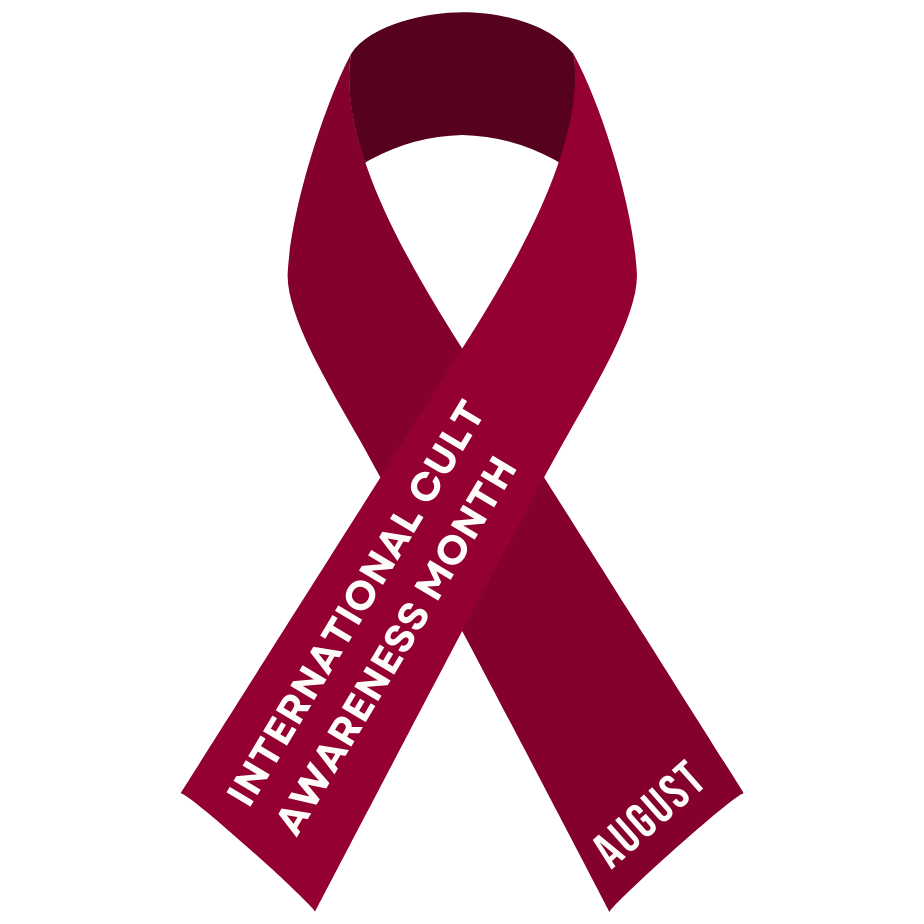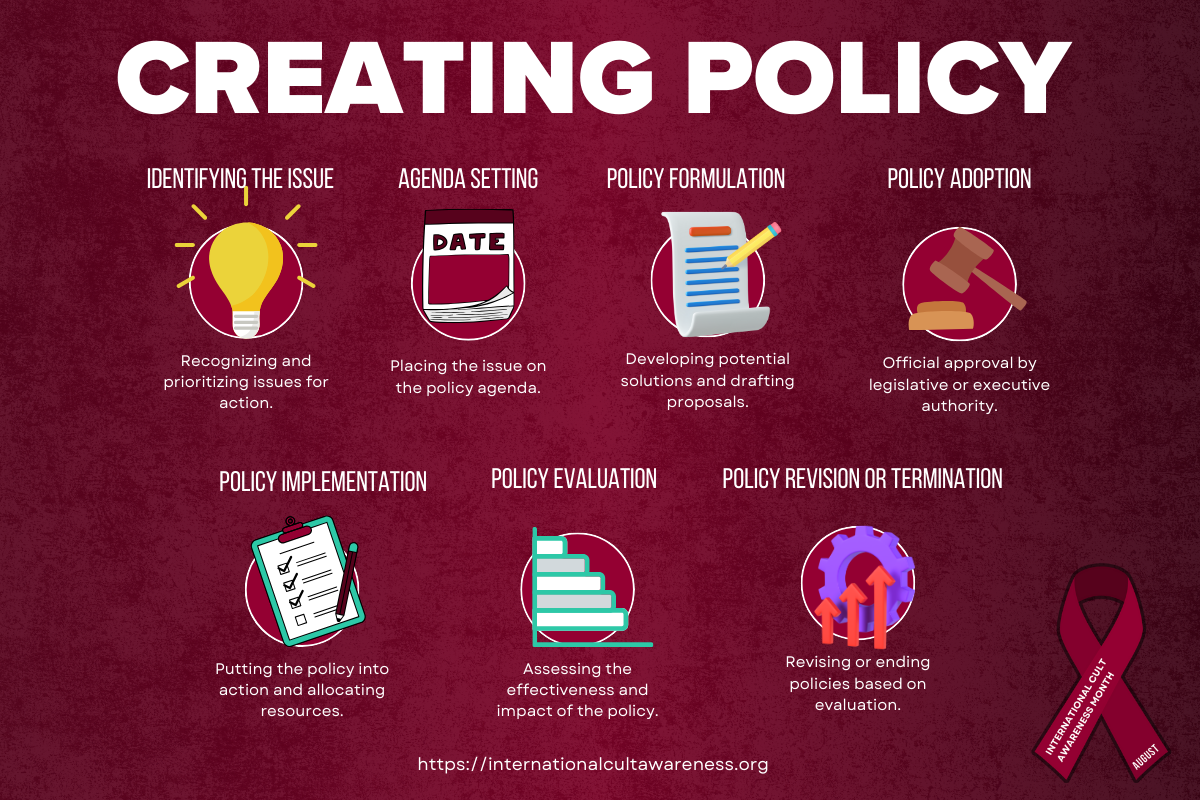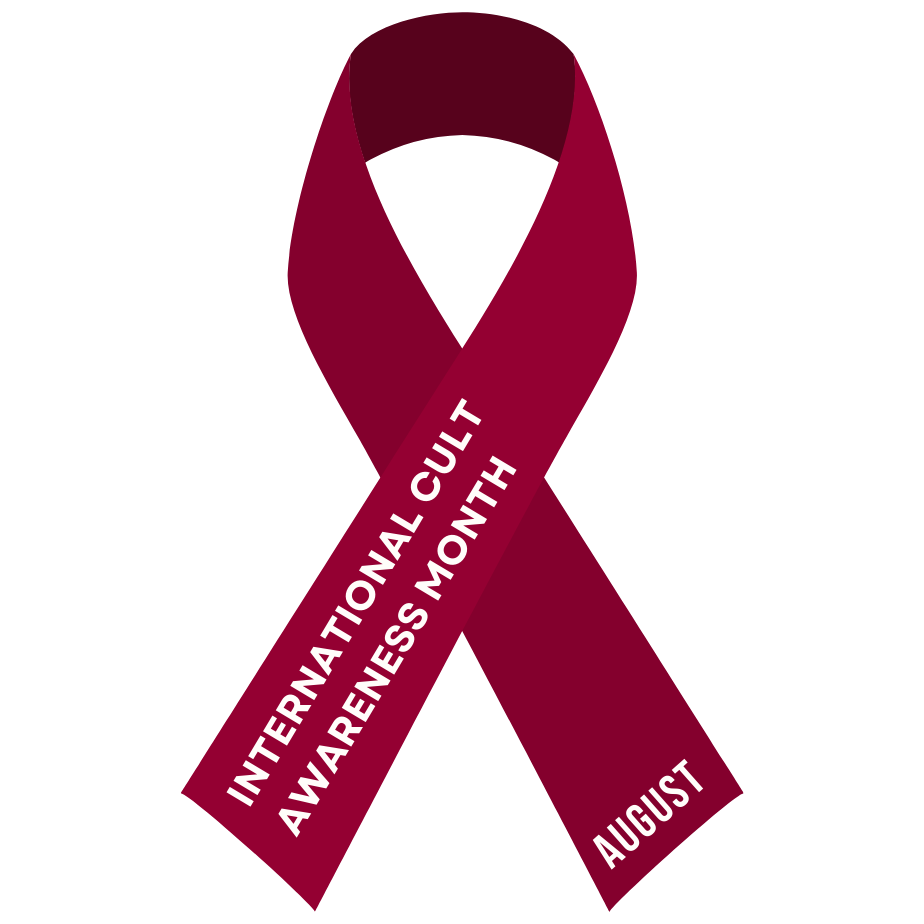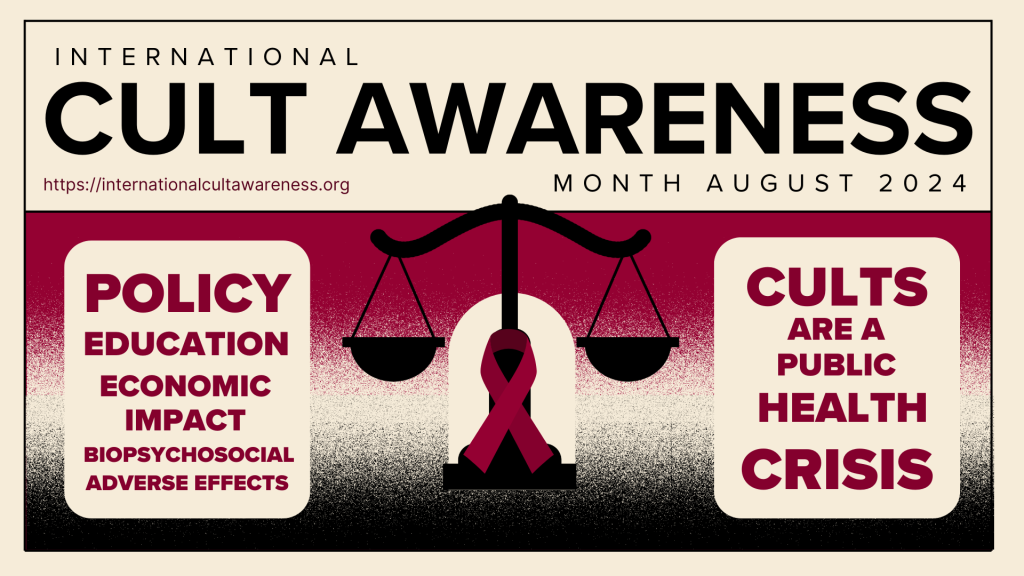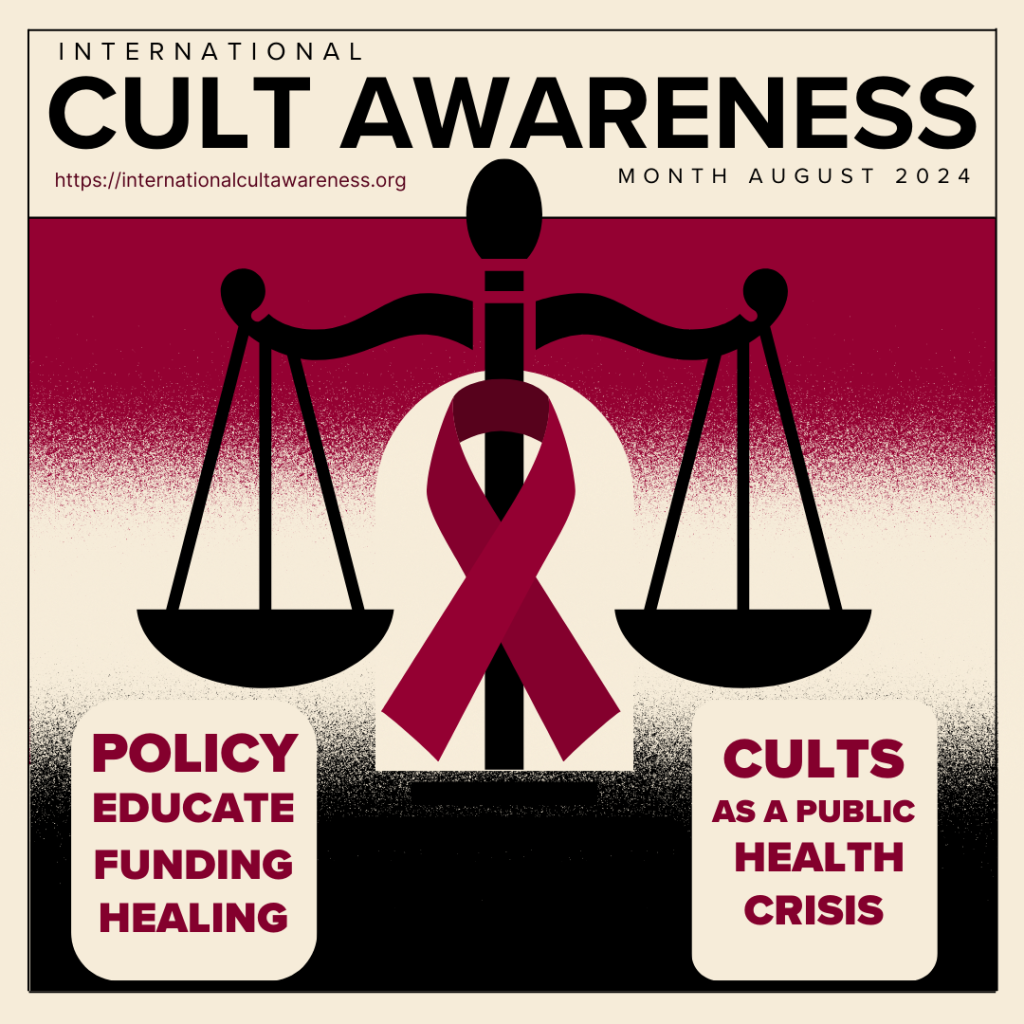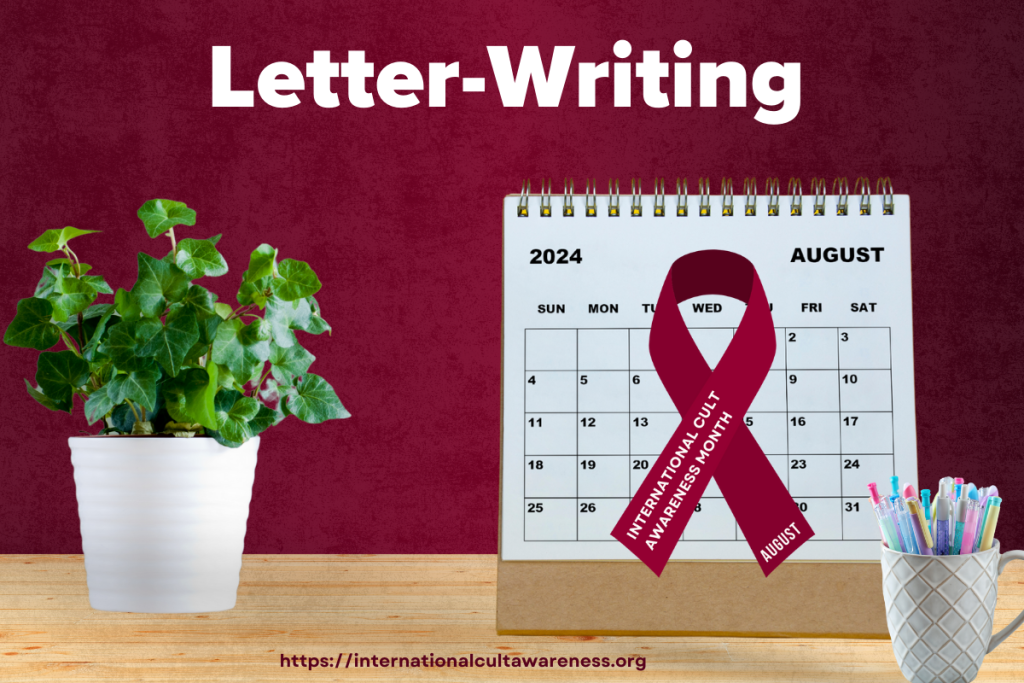Welcome to the second week of International Cult Awareness Month 2024! Last week, we focused on the basics of cults. This week, we focus on the intersection of policy and law-making, using coercion as the central point. As cults continue to impact individuals and communities worldwide, we must seek to help people understand the role that policy and legislation play in addressing and preventing coercive control. This method of abuse is a primary method that cults use to entrap their victims. Join us for a series of events, discussions, and resources designed to deepen your understanding of this critical issue.
Understanding the Policy and Law-Making Process: From Creation to Implementation
Introduction
Policies shape the way societies function, impacting everything from public health to education and from environmental protection to economic stability. But how exactly are these policies created, introduced, and implemented? The policy-making process is a complex and often lengthy journey that involves multiple stakeholders, careful planning, and rigorous debate. This blog will guide you through the key steps in the policy-making process, offering insights into how ideas become actionable policies that can influence our daily lives (Birkland, 2019; Howlett, Ramesh, & Perl, 2020).
Step 1: Identifying the Issue to Create Policy and Law
The policy and law-making process begins with identifying an issue that needs to be addressed. This can arise from various sources, such as public demand, emerging research, crises, or advocacy from interest groups. Policymakers, whether government officials, legislators, or even non-governmental organizations, must recognize and prioritize these issues as needing formal action (Hill & Varone, 2021).
Sources of Issues:
- Public Concern: Widespread demand for change, often spurred by events or social movements, can push an issue onto the policy agenda (Smith & Larimer, 2016).
- Research and Data: Studies and reports highlighting problems, such as health crises or environmental degradation, can prompt the need for policy intervention (Knill & Tosun, 2020).
- Crises and Emergencies: Natural disasters, economic downturns, or other emergencies often lead to the rapid development of new policies (Weible, 2023).
- Advocacy and Interest Groups: Lobbyists, NGOs, and other stakeholders often raise awareness of specific issues and advocate for new or reformed policies (Dye, 2017).
The first step in addressing the needs of cult victims is recognizing the issue at hand. This involves acknowledging the psychological, financial, and social harm that cults inflict on their members. Public outcry, survivor testimonials, and research findings highlight the urgent need for targeted interventions to protect individuals from such exploitation.
Step 2: Agenda Setting for Policy and Law
Once an issue is identified, it must be placed on the policy agenda. This step involves prioritizing the issue among many others that compete for the attention of policymakers. Successful agenda-setting often requires the backing of influential stakeholders, including politicians, media, and advocacy groups (Birkland, 2019).
Agenda-Setting Techniques:
- Framing the Issue: Presenting the issue in a way that highlights its importance and urgency (Stone, 2011).
- Building Coalitions: Forming alliances with other groups or stakeholders to strengthen support for the issue (Weimer & Vining, 2017).
- Media Influence: Leveraging media coverage to bring the issue to the forefront of public and political attention (Peters, 2018).
Once the issue is identified, it must be prioritized within the policy agenda. Advocacy groups, survivor networks, and concerned citizens play a crucial role in bringing the plight of cult victims to the attention of policymakers. Through media campaigns and public forums, they emphasize the importance of developing policies to prevent cultic abuse and support those affected.
Step 3: Policy and Law Formulation
Policy formulation is the process of developing potential solutions to the issue. During this stage, policymakers explore various options, weigh the pros and cons of each, and consult with experts, stakeholders, and the public to refine their proposals (Dye, 2017; Hill & Varone, 2021).
Key Elements of Policy Formulation:
- Research and Analysis: Gathering evidence, data, and expert opinions to inform the policy (Knill & Tosun, 2020).
- Drafting Policy Proposals: Creating detailed policy documents that outline the proposed actions, objectives, and implementation strategies (Weimer & Vining, 2017).
- Stakeholder Consultation: Engaging with those affected by the policy, including the public, interest groups, and industry experts, to gather feedback and make adjustments (Howlett, Ramesh, & Perl, 2020).
In the policy formulation stage, experts collaborate to design comprehensive strategies that address the needs of cult victims. This might include drafting legislation that provides legal protection for victims, funding for rehabilitation programs, and educational campaigns to raise awareness. Stakeholder input, including that of survivors, is vital to ensure the policies are effective and inclusive.
Step 4: Policy Adoption
Once a policy proposal is formulated, it must be officially adopted. This step typically involves approval by a legislative body, such as a parliament or congress, or by executive order in some cases. The adoption process can vary significantly depending on the type of policy and the governing structure (Hill & Varone, 2021).
Policy Adoption Process:
- Legislative Approval: In democratic systems, the policy proposal is often presented as a bill that must be debated, amended, and voted on by legislators (Birkland, 2019).
- Executive Action: In some cases, policies can be enacted directly by a head of state or government through executive orders or decrees (Peters, 2018).
- Judicial Review: In certain situations, courts may review policies to ensure they comply with the constitution or other legal frameworks (Weible, 2023).
After careful consideration and revisions, the proposed policy is brought before the legislative body for approval. Lawmakers debate the merits of the policy, considering its potential impact on victims and society at large. Once passed, the policy becomes a legal framework that mandates support services for cult victims and sanctions against cultic practices.
Step 5: Policy and Law Implementation
After a policy is adopted, the next step is implementation. This involves putting the policy into action, which may require creating new programs, allocating resources, and establishing procedures and guidelines (Howlett, Ramesh, & Perl, 2020).
Implementation Activities:
- Developing Implementation Plans: Creating detailed plans that outline how the policy will be put into practice, including timelines, responsibilities, and resource allocation (Weimer & Vining, 2017).
- Resource Allocation involves securing the necessary funding, personnel, and infrastructure to support the policy (Peters, 2018).
- Communication and Training: Ensuring those responsible for implementing the policy are well-informed and adequately trained (Birkland, 2019).
- Monitoring and Enforcement: Establishing mechanisms to monitor the effectiveness of the policy and enforce compliance where necessary (Hill & Varone, 2021).
With the policy now in place, the focus shifts to implementation. Government agencies, non-profits, and social services are mobilized to provide the necessary support to cult victims. This includes setting up counseling centers, legal aid, and reintegration programs, ensuring that the policy’s objectives are met effectively on the ground.
Step 6: Policy Evaluation
The final step in the policy and law making process is evaluation. Policymakers must assess whether the policy is achieving its intended goals and identify any areas for improvement. Evaluation can lead to policy revisions, further legislation, or even the abandonment of the policy if it is found to be ineffective (Dye, 2017).
Evaluation Techniques:
- Performance Measurement: Tracking key indicators to measure the impact of the policy (Weible, 2023).
- Feedback from Stakeholders: Gather input from those affected by the policy to understand its real-world effects (Stone, 2011).
- Impact Assessment: Conducting studies to evaluate the long-term outcomes of the policy, including unintended consequences (Smith & Larimer, 2016).
As the policy is implemented, ongoing evaluation is crucial to assess its effectiveness. Data is collected on the number of victims assisted, the success of rehabilitation programs, and the enforcement of legal measures against cults. Feedback from victims and service providers helps identify areas where the policy may need adjustments to better serve its purpose.
Step 7: Policy Revision or Termination
Based on the evaluation, policymakers may decide to revise the policy to address shortcomings or terminate it if it is no longer needed or effective. This step ensures that policies remain relevant and effective over time (Birkland, 2019).
Based on the evaluation results, policymakers may decide to revise the policy to address any shortcomings or to expand its scope. For instance, if certain regions or victim demographics are not receiving adequate support, revisions may be made to ensure broader coverage. Alternatively, if the policy has successfully mitigated the issue, it might be scaled down or integrated into broader legislative frameworks.
Conclusion
The policy and law making process is a dynamic and iterative cycle that requires careful consideration at every stage. From identifying issues to implementing and evaluating solutions, each step plays a critical role in shaping the policies that govern our lives (Hill & Varone, 2021; Peters, 2018). Citizens and stakeholders can better engage with the process and advocate for meaningful change by understanding how policies are created, introduced, and implemented. Whether you’re a policymaker, an advocate, or simply a concerned citizen, being informed about the policy and law making process empowers you to contribute to developing policies that address the needs of your community and society at large (Weimer & Vining, 2017).
Hashtags: #ICAM2024 #PolicyMaking #LawMaking #CultLegislation #ProtectTheVulnerable #EndCultAbuse #LegalReform #AdvocateForChange #CultsAndLaw #PolicyEducation #LegalProtection #CultsUnderLaw #LegislativeAction #PolicyAgainstCults #LegalAdvocacy #GovernmentIntervention #PolicyImpact #LawAndCults #PolicyAwareness #SupportLegislation
References
Dye, T. R. (2017). Understanding public policy (15th ed.). Pearson.
Hill, M., & Varone, F. (2021). The public policy process (8th ed.). Routledge.
Knill, C., & Tosun, J. (2020). Public policy: A new introduction (2nd ed.). Bloomsbury.
Weible, C. M. (Ed.). (2023). Theories of the policy process (5th ed.). Routledge.
Smith, K. B., & Larimer, C. W. (2016). The public policy theory primer (3rd ed.). Westview Press.
Weimer, D. L., & Vining, A. R. (2017). Policy analysis: Concepts and practice (6th ed.). Routledge.
Resources to Share for Building Strength
The following are various resources for this week for building strength and resilience. These are meant to share on your social media. These are just suggestions. If you share articles or books, it is recommended that you read them and describe why you like them. This also ensures you agree with the principle of each resource. If there are Amazon links, the sponsoring organization, The Freedom Train Project Incorporated, is receiving a percentage of sales to help victims of cults and coercive control.
